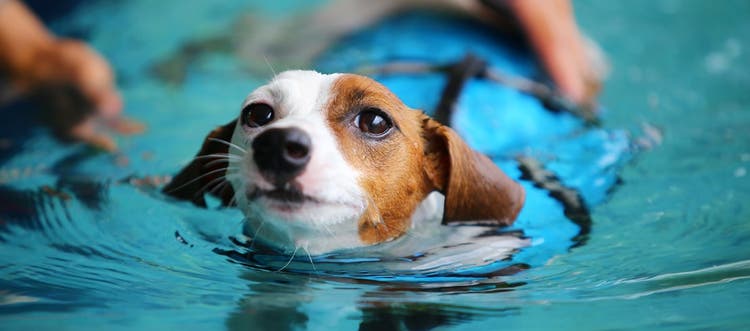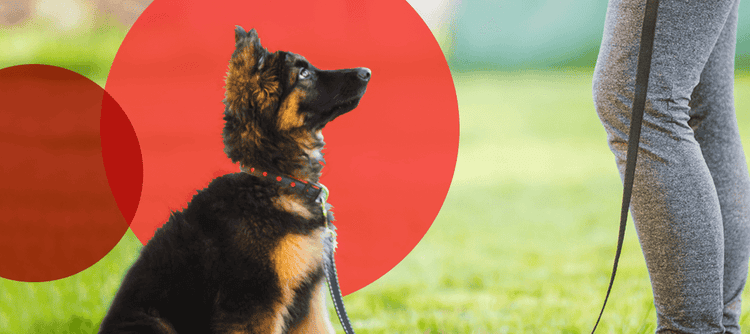Train your dog to run with you.
Everyone needs regular exercise — including dogs. Running with your dog can be a great way for both of you to stay in shape, create a lasting bond and burn calories in the process. However, even if you’re an experienced runner and your dog has energy to spare, running together requires practice and training — for both you and your dog.
Can Your Dog Run with You?
Before you start, confirm your dog is old enough to run with you. Most vets advise waiting until your dog is at least 1½ to 2 years old before you start distance running. No matter how old your dog is, it’s smart to get your vet’s approval to make sure your dog is up to the challenge.
Also consider whether your dog is genetically built for extended runs. Dogs with smaller snouts or scrunched-up noses such as pugs or bulldogs (brachycephalic dogs) will struggle to catch their breath, which can lead to additional health risks. Likewise, dogs with shorter legs and larger bodies, like corgis or basset hounds, will not be able to run very fast or far before tiring. If running isn’t for your pet, there are plenty of other ways to add variety to their exercise routine.
How to Train Your Dog to Run with You
Step 1: Work on Leash Training
Focus on leash training first — one of the key factors to successfully running with your dog.
If your dog tends to cross your path on walks, get them used to walking only on one side. When your dog crosses your path, stop and correct them. If they don’t understand, turn around and start moving again, gently pulling them to the correct side. Then turn back around and keep walking.
Also, make sure your dog walks without pulling on the leash. If your dog hasn’t been trained to heel, consider working on that to start. Running with your dog while they pull at the leash can throw off your balance and put you both in danger. If your dog naturally walks with a little bit of slack on the leash, you’re ready to move to the next step.
Step 2: Get Your Dog the Right Running Gear
Every runner has running gear, and your dog should be no different! First, make sure you have the right-sized leash: A standard 6-foot leash is ideal. Extendable leashes are not recommended for running because they could be a tripping hazard.
Second, make sure your dog’s collar or harness fits comfortably and doesn’t have any damage that could irritate their skin. Ideally, the leash and collar will have some reflective material to make you both more visible. Many runners prefer wearing a waist buckle they can attach the leash to, so they can keep their hands free and run with a more natural motion.
Step 3: Slowly Build Your Dog’s Endurance
Even if you have an energetic dog, running for a long distance may not be easy for them at first. Follow these general steps to start running with your dog:
- Start by giving a verbal cue before the run, such as “Let’s run!”
- Begin at a light pace and run a short distance, 100 yards or so, to see how your dog handles it.
- If all seems well, rest for 15 to 30 seconds, then give another verbal cue and double the distance.
- If your dog gets the hang of it, give the verbal cue and double the distance again.
- After three rounds, you’ll have run about one-third of a mile. Ideally, you should both stop running at this point and walk the rest of the way.
Give your dog at least 24 hours to recover before you run again. Maintain this same distance for a week, no matter how many times you run. After that, you can increase the distance by 5% to 10% every week. Keep in mind that this process isn’t just about increasing your dog’s cardio endurance; it’s also about building up the calluses on their footpads for protection.
Be sure to use the verbal cue every time you’re ready for a run. This will help your dog understand the difference between a normal walk and a cardio run.
Step 4: Learn Your Dog’s Limits
Most dogs with built-up endurance can run comfortably for about 2 to 5 miles. If you’re an experienced runner, you might want to go farther, but proceed with caution. Even if your dog looks OK, keep in mind that most dogs are people pleasers. Even if they start to feel discomfort, they might keep running with you at full speed, only to show signs of pain afterward.
Here are some signs to watch for and what to do:
- If your dog lags behind or stops completely, take a break.
- If your dog starts to pant excessively, find some water.
- If your dog’s tongue takes on a bluish tint, stop running immediately and monitor their condition, seeking vet care if necessary.
- If you think your dog has overheated, resist the instinct to let them drink all their water; instead, give them a reasonable amount and pour some on their head and back. Drinking too much water at once can be dangerous for dogs.

Tips for Running with Your Dog
Correct Often
When you first start running with your dog, they may weave in front of you, get distracted or want to stop running altogether. Practice patience and use consistent verbal commands without stopping. If that doesn’t work, stop running and guide your dog to the correct side. Then have them sit by your feet before giving the verbal cue to start running again.
Take Frequent Breaks
Your dog will need to take care of business on your run, so make sure you allow for frequent breaks. As your dog gets familiar with your new running routine, give them time to relieve themselves before you start.
Know Your Environment
Keep in mind that you’re protected from hot pavement by your running shoes, but your dog only has the pads on their feet. On warm days, place your hand on a sunny spot of pavement for a few seconds; if it’s hot to the touch, it’s probably too hot for your dog. Heat radiates off cement and blacktop too, and running next to busy street traffic can also increase your dog’s core temperature more quickly, so use caution and your best judgment. On especially hot days, you might opt for taking a swim with your dog instead to cool you both off.
For winter runs, try to avoid areas treated with salt. This can irritate your dog’s paws and make running painful, even if their calluses are built up.
By making sure your dog has the proper gear and basic leash training, and by slowly building their endurance, you’ll be enjoying regular outdoor runs with your favorite furry companion in no time.
References
- Becker, M. (n.d.). Ready, Set, Go: Running With Your Dog. Retrieved from https://www.vetstreet.com/our-pet-experts/ready-set-go-running-with-your-dog
- Gibeault, S. (2019, October 11). How to Train Your Dog to Be Your Running Companion. Retrieved from https://www.akc.org/expert-advice/training/how-to-train-your-dog-to-run-with-you/
- Health.com. (n.d.). Running With Your Dog: 17 Dos and Don'ts. Retrieved from https://www.health.com/pets/running-with-your-dog-17-dos-and-donts

DVM Daily Soft Chews® Multivitamin
A daily multivitamin soft chew containing minerals and antioxidants to supplement your dog's daily nutritional needs.











